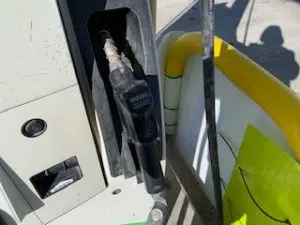Iowa
Two women from Arkansas — and the importance of public education • Iowa Capital Dispatch

In April of 2022, coming home from a meeting in Storm Lake on a Sunday afternoon, my truck busted down on Interstate 35 north of Roland. I called Kenny my mechanic, described the symptoms, and he said, “Probably the fuel pump — better get-r towed to the shop.”
Kenny knew the truck well; he sold it to me in 2018 or 2019 and it’s the best $2,000 I have ever spent. The truck is now 24 years old with only 175,000 miles on it — most of them put on by me.
I thought about getting a tow to Ames, finding a mechanic, spending the night in a hotel room and the mess that might come from not knowing a good mechanic or hardly anyone in Ames, and then maybe towing it again in the morning to a mechanic, and so I decided to have it towed to Kenny’s shop in Knoxville about 90 miles away.
The tow bill was $700, and I swore next time I went very far from home I would park my truck and get a rental car.
So I was at the car rental shop in Pella about 9 a.m. Thursday a week ago to pick up a rental car to drive to an event in Iowa Falls. I figured I would rather pay 70 bucks for a rental car than potentially another $700 tow bill. A sign on the door said, “back in 5 minutes.” I didn’t mind because it gave me some time to look for fossils in the landscaping gravel by the store.
A few minutes later, two women drove up in a black SUV and got out. I guessed one was in her 60s or 70s and dressed in gray from her hair to her running shoes. She was lean and hard like a desiccated leather rope. When I told her the attendant at the shop would be back in five minutes, she got mad and started cussing at me and the general wider world before she backtracked after realizing I wasn’t the problem. She explained she was angry because they were late and had somewhere to go “right now.”
Someone else might have been offended by the tongue-lashing but I found it fascinating.
The younger woman was maybe 35-40 with pretty red hair and freckles and was in pajamas. I guessed the older woman was her mom as they acted as if they were kin. The younger woman had looked at me with kindness and compassion in her eyes while the older woman had scolded me.
Maybe 10 minutes later, a young man chewing on a Casey’s breakfast burrito walked up, apologized for taking so long, and welcomed us in. The old woman gave him an earful as he helped me fill out my paperwork as I had been first in line. After a few minutes, I walked out into the parking lot with my keys to a Kia which looked like a toy. It was so low to the ground that I feared I would wear out the seat of my pants on the asphalt before I had driven a mile.
When I came out, the younger woman was still looking at the gravel.
“Find anything good?” I asked.
She gave me a big smile and said, “Can I show you?”
“Sure!”
She jogged over to me holding several rocks and said, “I just look for the pretty ones!”
As she put the rocks in my hand she told me they were visiting from Arkansas.
“Oh, these are pretty,” I said, turning them over in my hand. “All quartz.”
Her eyes grew big and she cocked her head at me looking puzzled.
“What’s quartz?” she said. “How do you know that?”
I was taken aback. How did I know that the rocks were quartz? How does anyone know a rock is quartz? How could she not know what quartz was?
“I learned it in school, I guess. It’s a crystalline igneous rock mostly formed in volcanoes.”
She gave me a look of astonishment and picked up another rock and showed it to me.
What’s this?”
“It’s another kind of igneous rock — chert. It has a tight molecular structure and was used by cultures all over the world to make stone tools in the past. You can bust it up with a harder rock and shape it into an arrowhead, spear point or other sharp tool.”
Her jaw dropped. She looked at me like I was saying brilliant, amazing things. “How do you know that?”
I didn’t know how to answer.
But I knew she was eager to learn, so I started picking up random rocks and figuring them out.
“Look at this — it’s petrified wood,” I said as I handed it to her.
“How do you know that?”
“You can see it looks just like the physical structure of the inner part of a tree. See the rings? Over millions of years, it turned into a fossil.”
“How does that happen?”
“There are minerals in water and over millions of years the minerals replace the cellular structure of the plant, turning it into a rock.”
She looked at me like I was the smartest person in the world and I had just described something as significant as the origins of the universe. While my knowledge seemed mundane to me, to her it was wonderful. Actually, what I had said was indeed wonderful, in that knowledge passed down to me had been created by scientists and other scholars working and learning for generations, but we don’t often think of that. That goes for everything we know, and we should probably appreciate it more.
Behind me I heard the door of the rental car agency open and out came her mom in a kerfuffle. “Let’s go,” she shouted, walking angrily away toward her rental car.
The younger woman started pulling away from me, walking backwards toward her mom and the car she was getting into.
“Can I keep these rocks?”
“Sure!”
“How do I learn more?” she asked, almost in desperation. By now she was 20 feet away from me, still retreating, and she cried again, “How do I learn more?”
She reached her hand out to me, even as she continued to retreat.
“Get in!” her mom yelled.
I reached my hand out in return into the space between us, almost as I was trying to rescue her from drowning in a raging river, but in vain.
So much came to mind to tell her. Textbooks, fossil field guides, college classes, the internet; it all swirled in my head as I sought the right thing to say to someone so eager to learn.
I fumbled for the right answer in those seconds, but finally, it came to me.
“Go to a library!’ I shouted. “Any library! The librarians will help you learn! They will be happy to teach you! They know how! Ask a librarian!
She gave me a big smile, got into the car with her mom, rolled her window down, stuck her head out of it, and continued to smile and wave to me until the car was out of sight.
As I drove to Iowa Falls, I contemplated how a person who was clearly curious and intelligent could know so little about rocks and fossils and how to learn about them. I realized that she had likely never been exposed to a public education. That her mother had cruelly isolated her.
I know people who homeschool their children and they do a great job. Their kids are well-educated and integrated into the community. I’m not worried about these kids.
Gov. Kim Reynolds and Republican legislators have been working hard to dismantle Iowa’s public schools in favor of private schools with vouchers that put public money into private schools. Out-of-state online companies have popped up that will provide homeschooling curriculum in exchange for voucher payments.
I hope I’m wrong, but perhaps the next step is for Reynolds to cut a check directly to those who are homeschooling their children with no oversight. Unlike my friends who do a great job homeschooling their kids, I think many will see it as Reynolds giving them thousands of dollars per kid as an incentive to keep them home.
Some of these children will likely be abused and neglected with no oversight, and we will have more children like Natalie Finn and Sabrina Ray. Others will most certainly enter the juvenile justice system.
And a great many children who will not meet their full potential, like the woman I met from Arkansas.

Iowa
Many Iowa rivers are brimming with nitrate • Iowa Capital Dispatch

Nitrate contamination of Iowa’s rivers has surged in recent weeks amid heavy, widespread rainfall, according to data collected by the Iowa Water Quality Information System.
Concentrations of nitrate in several large waterways — including the Boone, Cedar, Iowa and Turkey rivers — have recently reached four-year peaks, the data show. Further, many of the affected rivers also have much higher than usual stream flows, according to the U.S. Geological Survey. That often reduces the concentrations.
Because the flows and concentrations are so high, the total nitrate load is also very high.
“This is one of the biggest nitrate leaching events in 11 years,” said David Cwiertny, director of the Center for Health Effects of Environmental Contamination at the University of Iowa.
It’s not yet clear how the level of river contamination this year will compare with others, but those who research the state’s water quality had predicted an “epic” uptick in pollution when significant rainfall returned following years of drought.
Research has shown that nitrogen fertilizer can accumulate in farm fields during dry years and leach in large amounts into streams following the droughts.
In several recent weeks — including the week before last — the state had more than double its typical rainfall. The area of the state that has some measure of drought has shrunk by more than half in the past two months, according to the U.S. Drought Monitor.
Elevated levels of nitrate and phosphorus in rivers can accelerate algae and plant growth and diminish the amount of oxygen that is available for other aquatic life. They are primary causes of the Gulf of Mexico’s dead zone.
In Iowa’s lakes they feed algae blooms that can make the water unsafe for swimming.
And higher concentrations of nitrate in the Des Moines and Raccoon Rivers can affect the largest drinking water supply in the state. On Monday, Des Moines Water Works began operating its nitrate removal system as the concentration in the Raccoon River — one of its primary sources of water — surpassed 15 parts per million. In March it was about 1 part per million, according to DMWW data.
Federal rules require public water supplies to have no more than 10 parts per million in their treated drinking water. Before last week, DMWW only used the removal system once since the drought started about four years ago.
“Nitrate concentrations vary greatly year to year based on weather conditions and river stages,” said Melissa Walker, a DMWW spokesperson. “What we are seeing today is very common with what we have seen historically for the past couple of decades during similar weather patterns.”
Other rivers had higher amounts of nitrate last week, according to the Iowa Water Quality Information System. The Turkey River near Garber had 18 parts per million. The Cedar River near Janesville had 24 parts per million. And the Boone River near Webster City had 25 parts per million.
The state’s Nutrient Reduction Strategy seeks to reduce the amount of nitrate in rivers by 45% through farmers’ voluntary conservation practices. River monitoring in the past 10 years has not shown significant progress toward that goal — which has no deadline — but state agriculture officials have said they are accelerating the installation of bioreactors, buffers and wetlands.
Iowa
Gas Prices Slightly Lower This Week

(Des Moines) According to AAA, the price of regular unleaded gasoline fell two cents this week, averaging $3.28 across Iowa, which is two cents lower than one year ago. The national average on Wednesday was $3.64, down two cents from last week’s price.
The price of global crude oil fell this week on the West Texas Intermediate by $2.99 per barrel over last week. It is currently priced at $78.40. Brent crude oil fell by $2.64 and is currently priced at $83.07. One year ago, West Texas Intermediate crude sold for $73.16, and Brent crude was at $77.76.
Retail diesel prices in Iowa fell 3 cents this week, with a statewide average of $3.69. One year ago, diesel prices averaged $3.79 in Iowa. The current Iowa diesel price is 28 cents lower than the national average of $3.97.
Wholesale ethanol held steady and is currently priced at $2.16. The current Des Moines Terminal/Rack Prices are $2.31 for U87-E10, $2.63 for Unleaded 87 (clear), $2.49 for ULSD#2, $2.76 for ULSD#1, and $1.99 per gallon for E-70 prices.
Natural gas prices rose 29 cents at the Henry Hub reporting site and are currently at $2.21. Throughout the summer months, we will only report retail heating oil and propane prices in Iowa once a month.
At Western Iowa Today, we strive for reporting accuracy. If you see a mistake or a typo, please let us know by email to news@westerniowatoday.com.
Story Content (c) 2024 Meredith Communications LC – All Rights Reserved.
Iowa
African American Museum of Iowa reopens

CEDAR RAPIDS, Iowa (KCRG) – Eastern Iowans got their first look at the new and improved African American Museum of Iowa as it reopened Saturday after a year of renovations. Both the museum’s exterior and interior got a complete makeover.
One of the newest features is an interactive research lab. It allows people to find out more about their own family history.
But Museum leaders said the museum is about more than just the exhibits.
“We hope people will be able to not only learn new content and learn history that they’ll be able to have a conversation and engage with the material. Then maybe do some reflection. You know what can I do to make an impact in my community?” said LaNisha Cassell, African American Museum of Iowa Executive Director.
Cassell said right now their temporary exhibit is a look at the museum’s 30-year history.
She said their next temporary, Racist Things: Hateful Imagery in the American Household is set to debut in September.
Copyright 2024 KCRG. All rights reserved.
-

 Education1 week ago
Education1 week agoVideo: President Biden Addresses Campus Protests
-

 Movie Reviews1 week ago
Movie Reviews1 week agoSabari Movie Review: Varalaxmi Proves She Can Do Female Centric Roles
-

 World1 week ago
World1 week agoEuropean elections: What do voters want? What have candidates pledged?
-

 News1 week ago
News1 week agoWhistleblower Joshua Dean, who raised concerns about Boeing jets, dies at 45
-

 Politics1 week ago
Politics1 week agoAustralian lawmakers send letter urging Biden to drop case against Julian Assange on World Press Freedom Day
-

 World1 week ago
World1 week agoBrussels, my love? Champage cracked open to celebrate the Big Bang
-
News1 week ago
A group of Republicans has united to defend the legitimacy of US elections and those who run them
-

 Politics7 days ago
Politics7 days agoHouse Dems seeking re-election seemingly reverse course, call on Biden to 'bring order to the southern border'




















